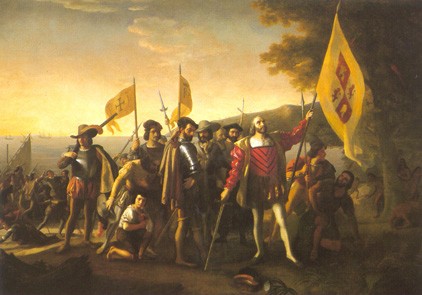
Back to Fall 07 English Calendar
Essay 1: Surprise and Inform
 |
John
Vanderlyn (1775-1852), Landing of Columbus on the Islands of
Guanahani, West Indies. Oil on canvas, 12' x 18' Commissioned 1836/1837; placed 1847. U.S. Capitol Rotunda |
A large part of the mission of these classes is to look at early American history from a nontraditional perspective which seeks to correct historical myths and misconceptions. You may have already been surprised by something you have learned while listening, watching, reading, or writing. What material have you encountered that has challenged some of your assumptions about the dominant narrative of our nation? Have you heard some new or different voices from the margins of that story? Have you discovered that you knew only part of the story? Have you seen how a painting can not only be an artistic object but an argument?
For your first essay, you will be asked to write an informative essay that questions a common assumption about an aspect of early American history that we have covered in History or English class. Imagine an audience of general readers who hold a common view of your topic. Your purpose is to give them a new, surprising view. Pose a problem or question, provide the commonly accepted view, and then give your own new interpretation, based on information you’ve learned in these courses.
Additionally, your new view doesn’t necessarily have to diametrically opposed to the common view. Perhaps you’ve discovered that the common view is incomplete or insufficient rather than dead wrong. Instead of saying, “View X is wrong, whereas my view, Y, is correct,” you can say, “View X is correct and good as far as it goes, but my view, Y, adds a new perspective.” In other words, you can also create interest and surprise by going a step beyond the common view to show the reader something new. You can advance the conversation in new and interesting ways.
Your essay should begin with an introduction that includes a clear thesis, or “road map.” You should outline what you intend to do in the essay and then follow through. Carefully include in-text parenthetical citations for any material you either quote directly or paraphrase. Conclude your essay with a separate Works Cited page in which you arrange your sources, including the sources for your images, alphabetically according to MLA standards.
Your essay should be 750-1000 words in length. Include 2 images in your paper to illustrate your position. Remember to cite the sources for images.
Each week the list of possible topics will grow longer. Possible topics:
- Reinterpret
the commonly held view of the world in 1492, i.e. Europe as the world’s
most advanced civilization, using material found in “eXplorations”
from Digital History. You might also expand the view that the importance
of 1492 lies only in Columbus’ voyage to the New World.
http://www.digitalhistory.uh.edu/learning_history/index.cfm - Write an essay in which you challenge the commonly held assumption about what “history” is. Could you explain examples of how “history” is shaped by authors and the times in which they live?
- Write
an essay that challenges the traditional view of:
1. life in the “golden age” of Elizabethan England, or
2. the validity of celebrating Columbus Day, or
3. the popular “Disney” view of Pocahontas, or
4. the identity of the first slaves in America. - Write
an essay about artistic portrayals of historic events, arguing that
art can be more than simply representational, as having a point of view
and advancing a claim about the subject matter.
For the Vanderlyn painting of Columbus’ landing in the Americas and the Rivera painting of Cortes at Vera Cruz:
http://www.digitalhistory.uh.edu/learning_history/spain/spain_art.cfm
For the Columbus Doors:
http://www.aoc.gov/cc/art/coldoors/columbus_doors.htm
You can probably find many more examples of art with historic themes. - Anything surprising that you have heard in either English or History could be crafted into an essay.
Checklist:
- Paper typed in standard 12 point font, stapled in the left-hand corner
- 750 - 1000 words in length
- Original title that catches the reader’s interest
- Introduction with clear thesis statement
- Paragraphs that support the thesis
- Conclusion
- 2 images
- Writing consultation
Essay due – beginning of class, Thursday, October 4
Material for this assignment drawn from John D. Ramage and John Bean, The Allyn & Bacon Guide to Writing. Boston: Allyn & Bacon, 2000.
Images:
Vanderlyn, John. Landing of Columbus on the Islands of Guanahani, West Indies. 1847. Onlie image. U.S. Capitol Rotunda 12 September 2005. <http://www.aoc.gov/cc/art/rotunda/landing_columbus.cfm>
